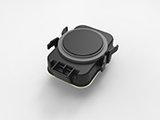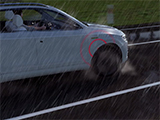- Login
- LOGIN-AREA
- Aftermarket Club
- Deutsch
Technology & Products / 26.11.2019
SHAKE technology from HELLA goes into series production
- Technology supports "Porsche WET-Mode" in the new Porsche 911
- HELLA wetness sensor detects moisture on the roadway
11/26/2019
11/26/2019
Drivers often underestimate wetness on the roads. Accidents frequently occur when tyres lose contact with the roadway causing them to lose traction when it is very wet. "If we are to reliably prevent this, drivers must be made aware of road conditions in good time so they can adapt their behaviour", says Michael Jaeger, a member of the executive board at HELLA's Electronics division, responsible for actuators and sensors.
In the field of driver assistance systems HELLA has therefore further developed the so-called SHAKE technology. This supplements existing assistance and safety systems, as it allows the vehicle not only to "see" its surroundings (e.g. via radar and camera systems), but to also "feel" them, thereby covering the invisible area between all driver assistance systems in the immediate vicinity of the vehicle. Using a piezoelectric element, the SHAKE sensor for example detects vibrations and airborne noise from water droplets swirled up in the air and determines the degree of wetness between tyre and road.
If the system of the new Porsche 911 detects a wet road, the response behaviour of Porsche Stability Management (PSM) and Porsche Traction Management (PTM) will be preconditioned. The driver also receives a warning and a recommendation to switch to WET-Mode. Various systems such as the response behaviour of the power unit then adapt to ensure maximum driving stability. "This is a great advantage over most systems available to date, which only warn the driver when a critical situation with very wet roads has already occurred", says Michael Jaeger. The wetness sensor also has potential for autonomous driving scenarios. "Because to determine static friction and thus braking distances, precise information about road conditions is vital. And this is exactly what the SHAKE sensor can reliably detect."
In Europe, the Porsche 911 has been available to customers since spring 2019. In addition to the SHAKE sensor, HELLA has also contributes interior lamps, body control modules and accelerator pedal sensors.
2019
Contact
Daniel Morfeld
Spokesperson / Media Relations
Rixbecker Str. 75
59552 Lippstadt
Phone: +49 2941 38-7566
Fax: +49 2941 38-477545
Daniel.Morfeld@forvia.com
Spokesperson / Media Relations
Rixbecker Str. 75
59552 Lippstadt
Phone: +49 2941 38-7566
Fax: +49 2941 38-477545
Daniel.Morfeld@forvia.com
03/22/2024



